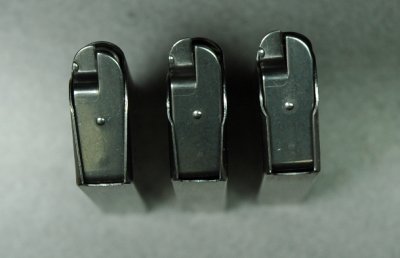Read My Lips
Cannon Fodder
Theory and Setup
Results
Conclusions
More articles
Discuss this article at

Unlike the previous analysis, I wasn't going to look at a wide range of magazines. The end result of all that variety was discovering that the most dramatic difference came from the shape of the magazine lips. This time around, the plan was to eliminate all variation except for the feed lips in order to see what difference the lips alone made. To do so, I'd have to find magazines that were structurally identical except for the lips. Fortunately, this is simple enough if you go with the original and still-ubiquitous seven-round design, which uses a welded baseplate, folded metal follower with a dimple on the top, and a strong (about 11 pounds) spring. This is the magazine John Browning designed to be part of the M1911 pistol.

A pile of old-school.
USGI
Well, sort of. Browning's blueprints call for long, tapered feed lips; magazines using this style of feedlips are known variously as "USGI", "hardball", or "ball-only" mags. For the purposes of brevity, this article will refer to the lip style and magazines featuring the lip style as "USGI".

Left: USGI-style fully-tapered feed lips.
USGI mags bear two conflicting reputations: They purportedly feed ball (i.e. full metal jacket) ammunition beautifully, but are said to choke horribly on hollowpoints or wadcutters. The latter reputation is the reason USGI magazines are in short supply nowadays: The 1911 rennaisance started with target guns feeding lead semi-wadcutters, a setup that for many Bullseye shooters caused an unacceptable number of alibis. This prompted modifications to the original design. At first, the tapered lips were "tuned" by gunsmiths to release rounds early by opening up the feed lips beyond a certain point; later, this was simplified to purely parallel feed lips with the desired early-release point. (More on both of these later.)
By the time the 1911 started seeing widespread acceptance as a defensive sidearm, the damage done to magazine design by its target-shooting era was done; USGI-style magazines were and still are vanishingly scarce. For a long time, the only source was military surplus, hoarded jealously by those who had them. Recently, though, magazine manufacturer Check-Mate started offering new tapered-lip 1911 magazines in blued and stainless finishes. This article will attempt to determine whether the reintroduction of the original design represents rediscovery of a classic technology prematurely tossed on the scrapheap of history, or whether it's merely a nod to nostalgia long since supplanted by superior alternatives.
Hybrid

Center: Colt-style hybrid feed lips.
As mentioned above, one of the first alternatives offered to the USGI design was tapered-lip magazines altered to release the round early. This modification preserved the initial taper, which let the round rise up as it was fed forward, but let the cartridge spring free of the magazine well before the same thing would occur with a full USGI taper. Although initially a modification, magazines came to be built with hybrid feed lips and Colt continues to use hybrids as its OEM mags for non-Gold Cup 1911s.
Wadcutter

Right: Parallel early-release "wadcutter" feed lips.
Ultimately, though, 1911 magazines would come to be dominated by short, parallel feed lips. These were the logical conclusion (some would say the reductio ad absurdum) of early-release tapered lips designed in pursuit of reliable feeding from wadcutters. As such, they're commonly referred to as "wadcutter" magazines or feed lips. Testing in my previous article had shown wadcutter mags feeding far less smoothly than hybrids, but that had been with ball ammo; would using actual wadcutters or short hollowpoints vindicate this design?
email: hidi.projects at gmail.com